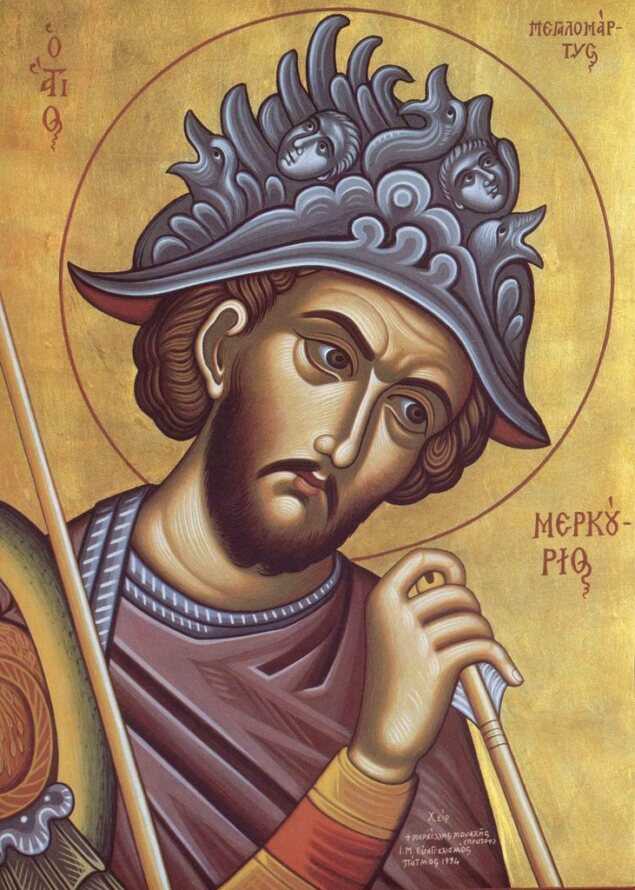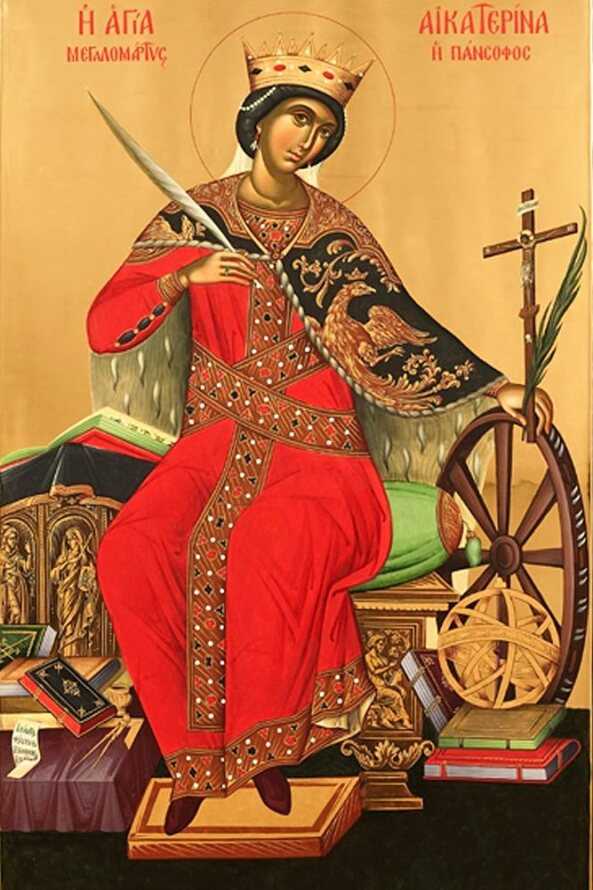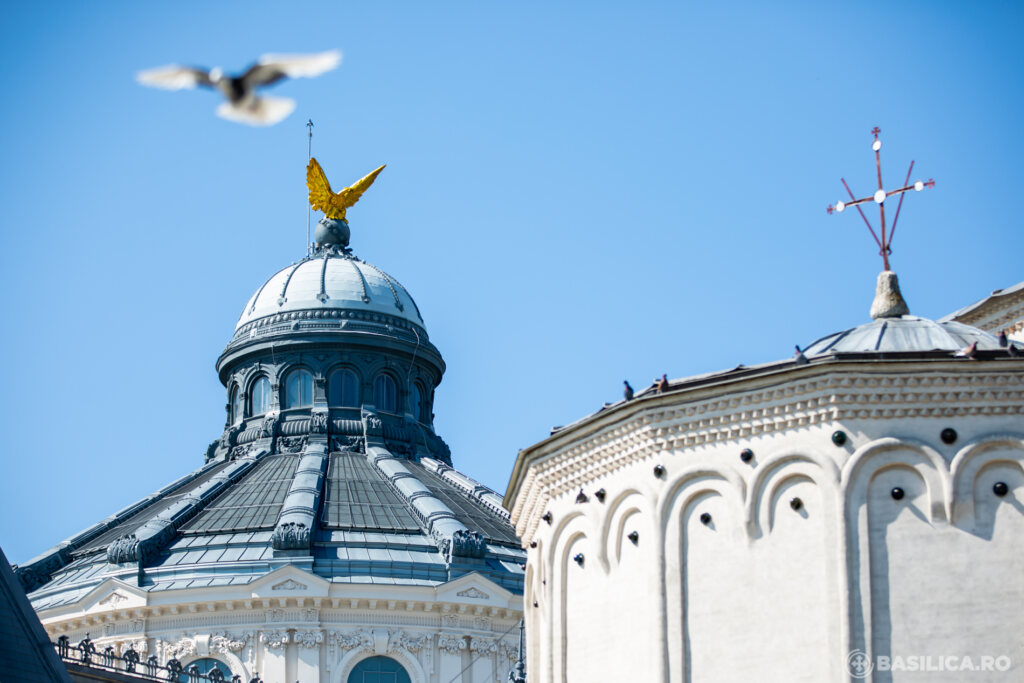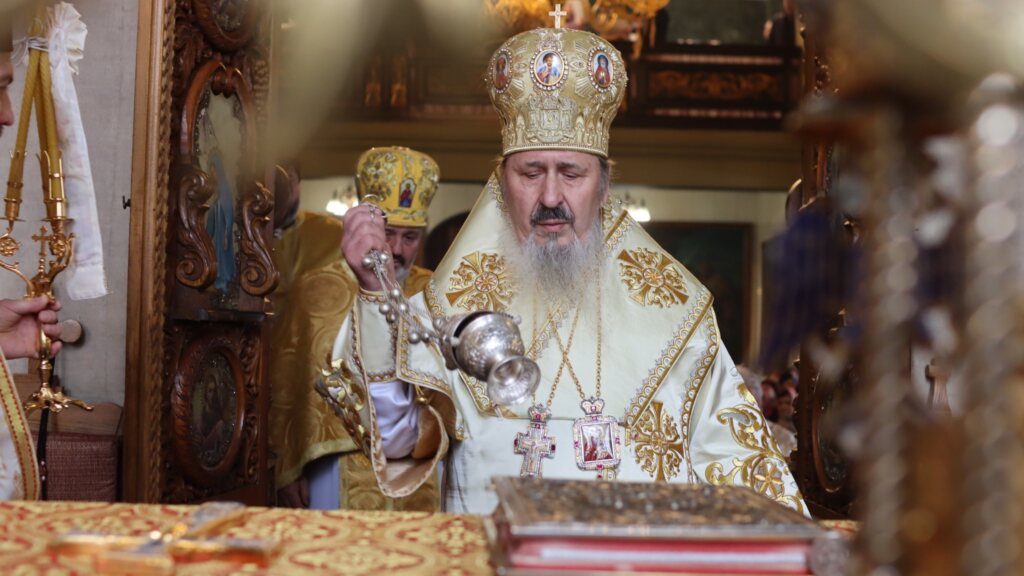Afterfeast of the Entry of the Most Holy Mother of God into the Temple
According to Holy Tradition, the Entry of the Most Holy Theotokos into the Temple took place in the following manner. The parents of the Virgin Mary, Saints Joachim and Anna, praying for an end to their childlessness, vowed that if a child were born to them, they would dedicate it to the service of God.
When the Most Holy Virgin reached the age of three, the holy parents decided to fulfill their vow. They gathered together their relatives and acquaintances, and dressed the All-Pure Virgin in Her finest clothes. Singing sacred songs and with lighted candles in their hands, virgins escorted Her to the Temple (Ps. 44/45:14-15).
There the High Priest and several priests met the handmaiden of God. In the Temple, fifteen high steps led to the sanctuary, which only the priests and High Priest could enter. (Because they recited a Psalm on each step, Psalms 119/120-133/134 are called “Psalms of Ascent.”) The child Mary, so it seemed, could not make it up this stairway.
But just as they placed Her on the first step, strengthened by the power of God, She quickly went up the remaining steps and ascended to the highest one. Then the High Priest, through inspiration from above, led the Most Holy Virgin into the Holy of Holies, where only the High Priest entered once a year to offer a purifying sacrifice of blood. Therefore, all those present in the Temple were astonished at this most unusual occurrence.
After entrusting their child to the Heavenly Father, Joachim and Anna returned home. The All-Holy Virgin remained in the quarters for virgins near the Temple. According to the testimony of Holy Scripture (Exodus 38; 1 Kings 1: 28; Luke 2: 37), and also the historian Josephus Flavius, there were many living quarters around the Temple, in which those who were dedicated to the service of God dwelt.
The earthly life of the Most Holy Theotokos from Her infancy until She was taken up to Heaven is shrouded in deep mystery. Her life at the Jerusalem Temple was also a secret. “If anyone were to ask me,” said Saint Jerome, “how the Most Holy Virgin spent the time of Her youth, I would answer that that is known to God Himself and the Archangel Gabriel, Her constant guardian.”
But there are accounts in Church Tradition, that during the All-Pure Virgin’s stay at the Temple, She grew up in a community of pious virgins, diligently read the Holy Scripture, occupied Herself with handicrafts, prayed constantly, and grew in love for God.
From ancient times, the Church has celebrated the Feast of the Entry of the Most Holy Theotokos into the Temple. Indications that the Feast was observed in the first centuries of Christianity are found in the traditions of Palestinian Christians, which say that the holy Empress Helen (May 21) built a church in honor of the Entry of the Most Holy Theotokos into the Temple.
Saint Gregory of Nyssa, in the fourth century, also mentions this Feast. In the eighth century Saints Germanus and Tarasius, Patriarchs of Constantinople, delivered sermons on the Feast of the Entry.
The Feast of the Entry of the Most Holy Theotokos into the Temple foretells God’s blessing for the human race, the preaching of salvation, the promise of the coming of Christ.
Troparion — Tone 4
Today is the prelude of the good will of God, / of the preaching of the salvation of mankind. / The Virgin appears in the temple of God, / in anticipation proclaiming Christ to all. / Let us rejoice / and sing to her: / “Rejoice, O Fulfillment of the Creator’s dispensation.”
Holy Great Martyr Catherine
she was the daughter of Constus, the governor of Alexandrian Egypt during the reign of the emperor Maximian (305-313). Living in the capital, the center of Hellenistic knowledge, and possessed of a rare beauty and intellect, Catherine received an excellent education, studying the works of the greatest philosophers and teachers of antiquity.
Young men from the most worthy families of the empire sought the hand of the beautiful Catherine, but she was not interested in any of them. She told her parents that she would enter into marriage only with someone who surpassed her in nobility, wealth, comeliness and wisdom.
Catherine’s mother, a secret Christian, sent her to her own spiritual Father, a saintly Elder living in a cave outside the city, for advice. After listening to Catherine, the Elder said that he knew of a Youth who surpassed her in everything. “His countenance is more radiant than the shining of the sun, and all of creation is governed by His wisdom. His riches are given to all the nations of the world, yet they never diminish. His compassion is unequaled.”
This description of the Heavenly Bridegroom produced in the soul of the holy maiden an ardent desire to see Him. “If you do as I tell you,” said the monk, “you will gaze upon the countenance of this illustrious man.” In parting, the Elder handed Catherine an icon of the Theotokos with the divine Child Jesus on Her arm and told her to pray with faith to the Queen of Heaven, the Mother of the Heavenly Bridegroom, and She would hear Catherine and grant her heart’s desire.
Catherine prayed all night and was permitted to see the Most Holy Virgin, Who said Her Divine Son, “Behold Thy handmaiden Catherine, how fair and virtuous she is.” But the Child turned His face away from her saying, “No, she is ugly and unbelieving. She is a foolish pauper, and I cannot bear to look at her until she forsakes her impiety.”
Catherine returned again to the Elder deeply saddened, and told him what she had seen in the dream. He lovingly received her, instructed her in the faith of Christ, admonished her to preserve her purity and integrity and to pray unceasingly. She then received the Mystery of holy Baptism from him.
Again Saint Catherine had a vision of the Most Holy Theotokos with Her Child. Now the Lord looked tenderly at her and gave her a beautiful ring, a wondrous token of her betrothal to the Heavenly Bridegroom (This ring is still on her hand).
At that time the emperor Maximian was in Alexandria for a pagan festival. Therefore, the celebration was especially splendid and crowded. The cries of the sacrificial animals, the smoke and the smell of the sacrifices, the endless blazing of fires, and the bustling crowds at the arenas defiled the city of Alexandria.
Human victims also were brought, the confessors of Christ, those who would not deny Him under torture. They were condemned to death in the fire. The saint’s love for the Christian martyrs and her fervent desire to ease their sufferings compelled Catherine to speak to the pagan priest and to the emperor Maximian.
Introducing herself, the saint confessed her faith in the One True God and with wisdom exposed the errors of the pagans. The beauty of the maiden captivated the emperor. In order to convince her and to show the superiority of pagan wisdom, the emperor ordered fifty of the most learned philosophers and rhetoricians of the Empire to dispute with her, but the saint got the better of the wise men, so that they came to believe in Christ themselves. Saint Catherine made the Sign of the Cross over the martyrs, and they bravely accepted death for Christ and were burned alive by order of the emperor.
Maximian, no longer hoping to convince the saint, tried to entice her with the promise of riches and fame. Receiving an angry refusal, the emperor gave orders to subject the saint to terrible tortures and then throw her in prison.
The Empress Augusta, who had heard much about the saint, wanted to see her. She prevailed upon the military commander Porphyrius to accompany her to the prison with a detachment of soldiers. The empress was impressed by the strong spirit of Saint Catherine, whose face was radiant with divine grace. The holy martyr explained the Christian teaching to them, and they were converted to Christ.
On the following day they again brought the martyr to the judgment court where, under the threat of being broken on the wheel, they urged that she renounce the Christian Faith and offer sacrifice to the gods. The saint steadfastly confessed Christ and she herself approached the wheels; but an angel smashed the instruments of execution, which shattered into pieces with many pagans standing nearby.
Having beheld this wonder, the Empress Augusta and the imperial courtier Porphyrius with 200 soldiers confessed their faith in Christ in front of everyone, and they were beheaded. Maximian again tried to entice the holy martyr, proposing marriage to her, and again he was refused. Saint Catherine firmly confessed her fidelity to the heavenly Bridegroom Christ, and with a prayer to Him she herself lay her head on the block beneath the executioner’s sword.
The relics of Saint Catherine were taken by the angels to Mount Sinai. In the sixth century,, the venerable head and left hand of the holy martyr were found through a revelation and transferred with honor to a newly-constructed church of the Sinai monastery, built by the holy Emperor Justinian (November 14).
Saint Catherine is called upon for relief and assistance during a difficult childbirth. Pilgrims to her monastery on Mt Sinai are given souvenir rings as a remembrance of their visit.
Troparion — Tone 4
By your virtues as by rays of the sun you enlightened the unbelieving philosophers, / and like the most bright moon you drove away the darkness of disbelief from those walking in the night; / you convinced the queen, and also chastised the tyrant, / God-summoned bride, blessed Catherine. / You hastened with desire to the heavenly bridal chamber of the fairest Bride-groom Christ, / and you were crowned by Him with a royal crown; / standing before Him with the angels, pray for us who keep your most sacred memory.
Holy Great Martyr Mercurius
He was of Scythian by descent, served as a soldier in the Roman army. The impious emperors Decius (249-251) and Valerian (253-259) issued a decree ordering all Roman citizens to worship the pagan gods, and condemning Christians to torture and death unless they obeyed the decree.
At that time barbarians attacked the Roman empire, and the emperor Decius went on campaign with a large army. In one of the battles an angel of the Lord appeared to Mercurius in the guise of a nobleman and presented him a sword saying, “Fear not, Mercurius. Go forth bravely against the enemy, and when you are victorious, do not forget the Lord your God.”
With this sword the holy warrior cut through the ranks of the barbarians. He also killed their king, winning victory for the Romans. The grateful Emperor Decius rewarded Saint Mercurius for his bravery, and made him commander of the entire army.
The angel of the Lord appeared again to the holy warrior, who had received great honors and riches, and reminded him by Whom the victory had been given. He also told General Mercurius that he would suffer for Christ, and would receive a crown of victory in His Kingdom. Mercurius recalled that his father Gordian had also confessed the Christian Faith. Although the saint had been baptized, he felt he had not devoted his life to God as his father and grandfather had done. Thus, he was weeping and lamenting when he was summoned before the emperor.
Decius consulted Mercurius on matters of state, then suggested that they offer sacrifice in the temple of Artemis. Not wishing to do this, the saint returned to his home. He was denounced as a Christian by a nobleman, whose name was Catullus. The emperor would not believe this, however, until he himself had questioned the saint.
Openly declaring himself a Christian, Mercurius threw down his military belt and cloak at the emperor’s feet, and he repudiated all the honors he had received. The angel of the Lord again appeared to Saint Mercurius in the prison, encouraging him to endure every suffering for Christ.
They stretched the holy martyr between four pillars and lit a fire beneath him. They cut his body with knives, and so much blood flowed from his wounds that it extinguished the fire. When they threw him back into the prison nearly dead from his wounds, Saint Mercurius was healed by the Lord, demonstrating the great power of Christ to the impious pagans.
Condemned to death, the saint was deemed worthy of a vision of the Lord, Who promised him a quick release from his sufferings. The Great Martyr Mercurius was beheaded at Caesarea in Cappadocia. His holy body emitted a fragrance like myrrh and incense. Many of the sick were healed at his tomb.
Even after his death the warrior of Christ performed a soldier’s service for the good of the earthly Church. Saint Basil the Great (January 1) once prayed before an icon of the Most Holy Theotokos, upon which Saint Mercurius was depicted as a soldier holding a spear.
He asked God not to permit the emperor Julian the Apostate (361-363) to return from his war against the Persians and resume his oppression of Christians. The image of the holy Great Martyr Mercurius, depicted on the icon beside the image of the Most Holy Theotokos, became invisible. It reappeared later with a bloodied spear.
At this very moment Julian the Apostate, on his Persian campaign, was wounded by the spear of an unknown soldier, who immediately disappeared. The mortally wounded Julian, as he lay dying, cried out, “Thou hast conquered, O Galilean!”
The Most Holy Theotokos, through the prayers of Saint Basil, had sent Saint Mercurius to defend the Christians from the apostate Julian. May we also be preserved from God’s foes, overcoming them through the prayers and assistance of Saint Mercurius.
Troparion — Tone 4
Your holy martyr Mercurius,O Lord, / through his sufferings has received an incorruptible crown from You, our God. / For having Your strength, he laid low his adversaries, / and shattered the powerless boldness of demons. / Through his intercessions, save our soul

Tr by oca.org






